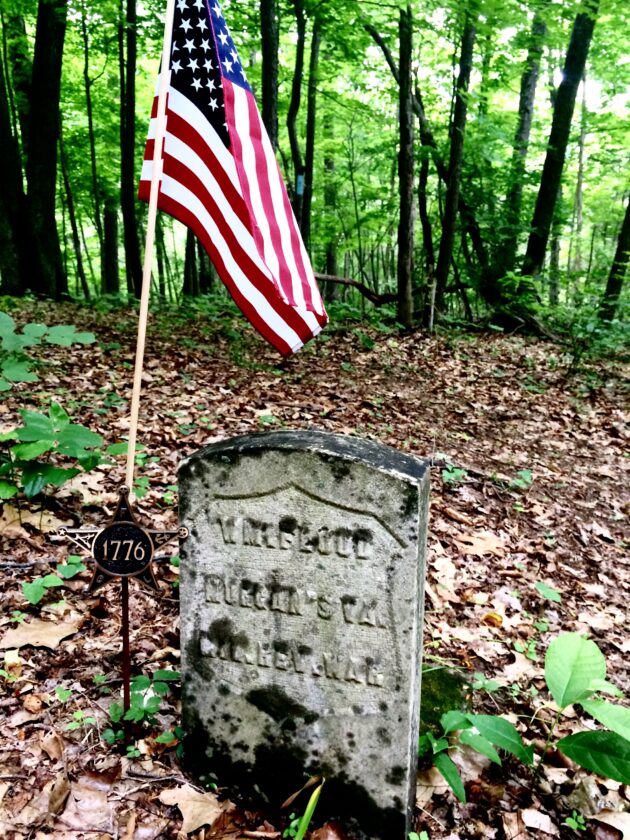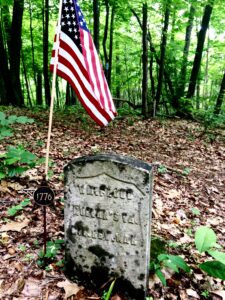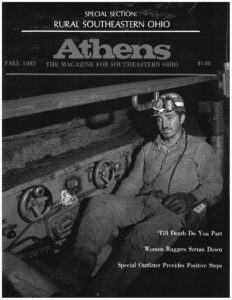Three brave veterans
- (Photo provided) Grave marker of William Flood, Adams County, OH.
- To learn more about these brave men, scan this code.

(Photo provided) Grave marker of William Flood, Adams County, OH.
The Grave. It was a moving sight, a solitary gravestone near a hiking trail. The Inscription: “Wm Flood. Morgan’s Va. (illegible) Rev War.” What did that mean? I found that William Flood served with Daniel Morgan’s Virginia Riflemen on the expedition to capture Quebec in late 1775. Flood was in the same campaign as two men with Marietta connections: Return Jonathan Meigs Sr. and Aaron Burr.
The Quebec Expedition: George Washington approved an expedition in late 1775 under Col. Benedict Arnold to capture Quebec and deny the British a base of operation. It was a disastrous operation. Everything that could go wrong did. Boats sank with loss of critical supplies. Maps were inaccurate. Weather turned bad. Illness was rampant. Food ran short. Men ate shoe leather, candle wax, a dog, and a horse to survive. Of the 1,100 men who started, about 500 turned back and several died.
The attack on Quebec finally began on December 31 at 5 am in a blinding snowstorm. Despite heroic fighting by Morgan’s Riflemen (William Flood’s unit) and others, the Americans were surrounded and captured. They were prisoners for 6 miserable months. They received only limited food. Poor nutrition brought on diarrhea and scurvy. Rations included a biscuit, rancid butter, molasses, salted beef or pork, and vinegar. Men played games such as All Fours, a card game, to pass the time.
William Flood had enlisted in Daniel Morgan’s unit in June 1775 at Winchester VA. Richard Henry described Morgan as “a large, strong bodied personage…, a strict disciplinarian…fearless of personal danger.” Service in Morgan’s Virginia Riflemen was arduous. To start, Morgan marched them 600 miles from Winchester to Boston in just 21 days, 30 miles a day!
William Flood served the rest of the Revolutionary War in Morgan’s unit. He then lived in Adams County, Ohio, perhaps on a land grant, living simply as a well digger. A pension application in 1818 poignantly states “…from unforeseen events I am in great need of aid… in my old age.” Flood was a shining example of the many ordinary men and women who have served our country.

To learn more about these brave men, scan this code.
Return Jonathan Meigs joined the Quebec expedition as a Major in September 1775. He became a Captain in the 6th Connecticut Regiment which served in Boston after the Battle of Lexington. Meigs kept a journal of the Quebec mission, writing in “ink” made of gun powder and water.
Meigs spent most of his time directing and assisting his men. His and and Richard Henry’s journal entries paint the challenging picture. Oct 3: “my (boat) filled with water…I lost my kettle, butter, and sugar,..” Oct 13 Henry: …we arrived at (camp) on the Dead River…pallid and weak, for want of substantial food…”Oct 16 Meigs: “Melancholy of the desperate kind oppressed me. (I feared) that we should die…in these wilds.” Nov. 2 “…marching this day was exceedingly bad. I passed soldiers who were without provisions and sick…” Return Jonathan Meigs served the rest of the Revolutionary War. He was one or the original settlers at Marietta in 1788. Meigs was a surveyor, later a judge and civic leader.
Aaron Burr, future US Vice President, leaped at the chance to join the Quebec campaign. He was fired up by patriotism and passion for the military. Burr quickly gained the respect of his fellow soldiers for his bravery, stamina, willingness to help others who faltered. Decades later, many who served remembered him for his bravery in that battle. His Captain, Richard Platt, testified that Burr “animated the troops, and made many efforts to lead them on…and might have succeeded, but for the positive order…to retreat.” Burr tried, unsuccessfully, to retrieve fallen General Montgomery’s body from the snow. Thirty years later, Burr’s own ill-fated expedition gained national attention and involved many at Marietta.



